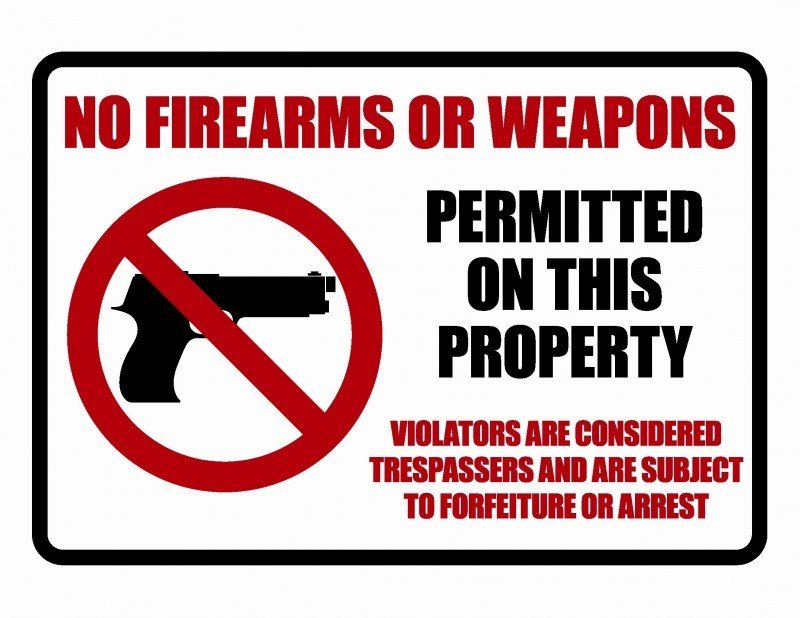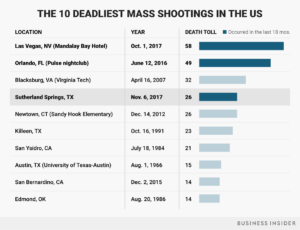
Weapons in the Workplace: Balancing Employee Safety with the Right to Bear Arms
November 10, 2017
 The shooter in the Sutherland Springs slaughter used a weapon that could fire off multiple rounds of ammunition in rapid succession. Those responsible for the Orlando and Las Vegas shootings, used similar weapon to gun down as many people as possible. There has been much debate over President Trump’s repeal of the Obama-era rule that disallowed mentally disabled people from purchasing firearms after the 2015 San Bernardino attack that left 14 people and 22 others seriously injured.
The shooter in the Sutherland Springs slaughter used a weapon that could fire off multiple rounds of ammunition in rapid succession. Those responsible for the Orlando and Las Vegas shootings, used similar weapon to gun down as many people as possible. There has been much debate over President Trump’s repeal of the Obama-era rule that disallowed mentally disabled people from purchasing firearms after the 2015 San Bernardino attack that left 14 people and 22 others seriously injured.
Now, in the aftermath, some members of Congress are yet again proposing legislation targeted at overhauling the current legislation and enforcing stricter gun laws. The Assault Weapons Ban of 2017 would ban the sale, transfer, manufacturing, and importation of military-grade assault weapons and high-capacity ammo magazines. Senator John Cornyn of Texas also plans to introduce legislation to augment and expedite the process of uploading of criminal conviction records into the National Instant Criminal Background Check System. On November 14, the Senate Judiciary Committee will hold a hearing to examine both federal and local government reporting of criminal convictions to the national database and the federal regulations for bump stocks, which can be used to increase the firing speed of semiautomatic weapons. Both Republicans and Democrats called for a ban on the sale of bump stocks last month after the Las Vegas massacre
Regardless of what a business owner’s personal opinion on gun control, it is imperative that employers cultivate a safe work environment and clearly communicate the rules of the workplace, especially when it comes to dangerous objects like guns and knives. How can employers reconcile workplace safety obligations with their employees’ right to bear arms?
Very carefully.
The Second Amendment of the U.S. Constitution states that, “[a] well-regulated Militia, being necessary to the security of a free State, the right of the people to keep and bear Arms, shall not be infringed.” While firearms are deadly and may contribute to additional violence, the possession of firearms by licensed citizens may also promote individual safety as well as safety in the community, demonstrated Stephen Willeford’s courageous pursuit of the gunman in the Texas church shooting.
About half of the states in the U.S. have passed parking lot laws that offer a compromise to employees licensed to carry firearms, allowing them to store guns in their personal vehicles, including the state of Georgia. According to Georgia Code 16-11-126(a), persons not prohibited by law from possessing a gun may carry their personal weapon on their property, inside their home, in their motor vehicle, or in place of business without a valid weapons carry license. This does not mean a Georgia employee is free to bring his or her gun to work. The Safe Carry Protection Act of 2014 allows Georgia employers to prohibit the possession of firearms in the workplace as long as the employer owns the property or has legal control of it.
It is critical for employers to have a clear workplace violence policy that addresses weapons on work property as well as broader safety issues. The first step is to develop a comprehensive, zero-tolerance workplace violence policy in alignment with state firearms possession and storage laws. Second, don’t limit the policy to firearms. Concentrate on fully assessing your facilities and determining how to make the workplace more secure overall, such as ensuring that the parking lot has adequate lighting. Background checks, proactive emergency-plan preparations and prompt investigations of the reported threatening behavior help to promote a safe work environment.
In the wake of this year’s increase in massing shoots, it is crucial that employers implement clear guidelines before a problem arises in the workplace and to provide supervisors with adequate training on how to handle a violent situation should one arise. When it comes to safety in the workplace, it’s far better to be safe than sorry.
Sources:
- http://www.latimes.com/nation/la-las-vegas-shooting-live-updates-death-toll-rises-up-to-59-killed-at-1506960544-htmlstory.html
- http://www.businessinsider.com/deadliest-mass-shootings-in-us-history-2017-11
- http://abcnews.go.com/Politics/efforts-emerge-capitol-hill-tackle-gun-control/story?id=51013503
- http://time.com/5010973/sutherland-springs-texas-mass-shootings-history/
- https://www.law.cornell.edu/wex/second_amendment
- https://www.nraila.org/gun-laws/state-gun-laws/georgia/
- http://blogs.hrhero.com/hrnews/2014/07/01/georgias-new-gun-law-has-implications-for-employers/
- https://www.shrm.org/hr-today/news/hr-magazine/1117/Pages/guns-in-the-workplace.aspx
